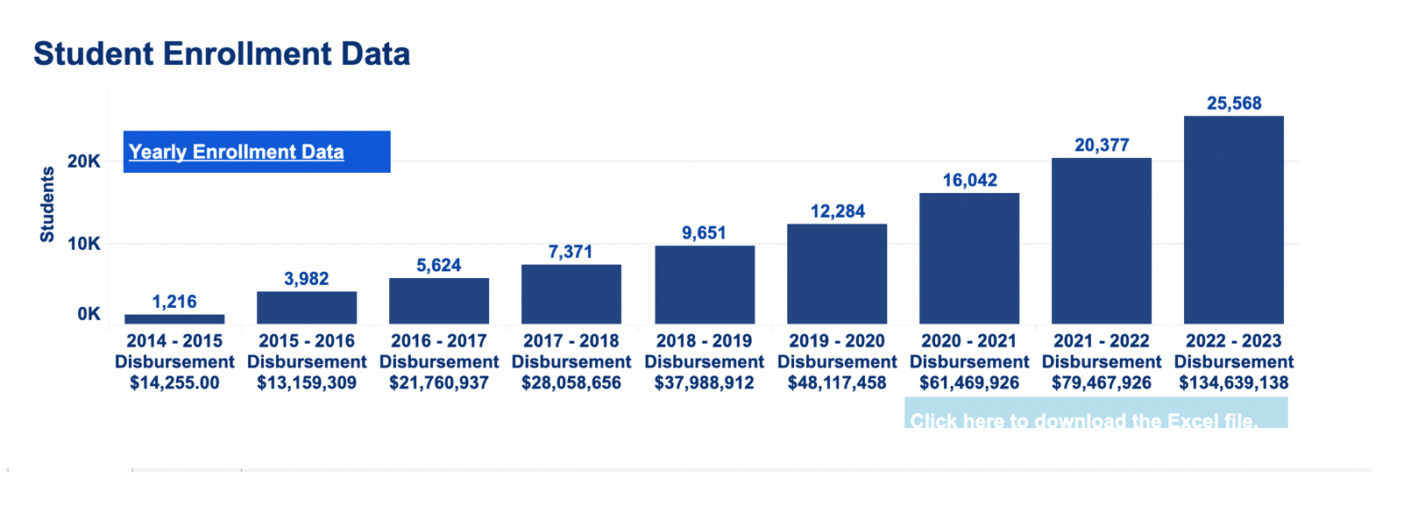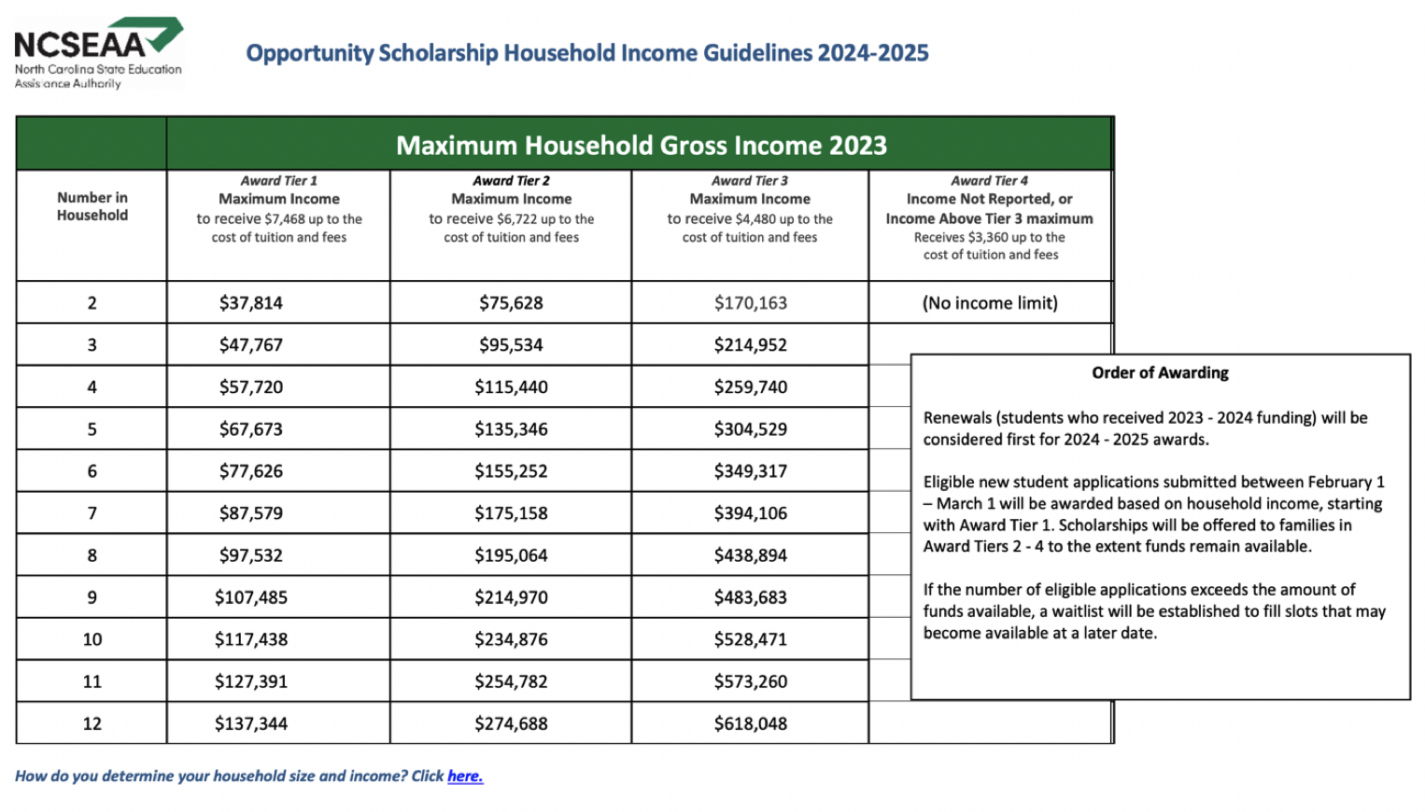A major expansion of school choice will get underway in North Carolina when applications for the larger Opportunity Scholarship Program begin this week. But that doesn’t mean the voucher program won’t face challenges. That’s due, in part, to the potential for increased demand combined with lagging funding to fulfill the scholarships in the upcoming school year.
Supporters and members of the media often label the expanded program as “universal school choice.” It is universal in the sense that every family with a school-aged child in the state can now apply for a scholarship. Access to those scholarships, though, will remain limited by the amount of money budgeted for the program.
Opportunity Scholarships are the state’s voucher program meant to defray the cost of a private-school education for families that choose such a route. The program has been around since 2013 and has steadily grown in popularity. The number of students receiving Opportunity Scholarships has more than doubled since the 2019-2020 school year and the beginning of the pandemic.

In response, lawmakers passed a massive expansion in 2023 that opens scholarships to all families, regardless of income, and expands the piggy bank for the program to more than $505 million in a reserve fund by the 2031-2032 school year.
But a funding problem could crop up in the short term. Lawmakers appropriated $177 million for the program’s reserve fund for the 2023-2024 school year, an amount that increases to $192 million for the 2024-2025 school year. The following year, the program gets a significant funding uptick to $416 million.
The question: For the upcoming school year, could demand outstrip the funding available, given the modest increase in spending coupled with the expansion of families who qualify?
The new approach
To answer that question, it’s important to understand how the new system works. Families already receiving Opportunity Scholarships get first priority for renewals. The priority window for new families to apply is Feb. 1 to March 1. The lowest income tier gets first priority on receiving scholarships —$57,720 a year or less for a family of four — and each applicant is entered into a random lottery. The next tier — those making $115,440 annually for a family of four — get the next priority, also by lottery.
Assuming any funds remain, students in the third and fourth tiers are offered scholarships in a lottery as well. These income levels have drawn the most scrutiny: For the third tier, it’s those making $259,740 or less for a family of four, while the fourth tier is any household income above the third tier maximum amount.

The awards are announced to the winning families in early April. Students who aren’t awarded are added to a waitlist and are considered for a later award — likely announced in May or June.
Running out of money?
As of Dec. 13, 32,170 students were receiving Opportunity Scholarships for a total allocation of $95 million for the fall semester. According to the North Carolina State Education Assistance Authority, or NCSEAA, those funds are approximately half the amount available for the entire school year, meaning the demand is now approaching $200 million for the current school year.
The bottom line: While applications are likely to go up due to the universal nature of the program beginning this year, the funds are only marginally higher.
According to data from the Department of Non-Public Education, there were 126,768 students enrolled in private schools for the 2022-2023 school year. About one-in-five of those students were receiving an Opportunity Scholarship. That leaves ample demand for new scholarships, not even factoring in families enrolled in alternatives to private schools who might want to make a switch — but again, limited funding.
Many of the students enrolled in the program currently roll over to the next year as well. For example, in the 2022-2023 school year, 83% of students continued on to receive a scholarship the following school year, according to data from NCSEAA.
Former state lawmaker Paul “Skip” Stam, a key architect of the original Opportunity Scholarship bill in 2013, cautioned that the current set up could pose political challenges this year for the legislative Republican majority.
“High income parents will not actually get the voucher for years, but every ad run by Democrats will feature millionaire parents on the dole, while grandma in a wheel chair is being thrown off a cliff,” Stam wrote in a letter to lawmakers in November.
Dr. Robert Luebke, director of the Center for Effective Education at the John Locke Foundation, pointed out that the supply of private schools in the state is another potential hurdle.
“We need for the supply of schools to catch up with the demand,” he noted. “That’s why a phased-in approach is best as the state adjusts to universal school choice.”
Scholarships are popular
The most recent Carolina Journal poll of likely NC voters put support for Opportunity Scholarships at 64% to 26% opposed.
The scholarship program is helping parents like Kara Millard of Raleigh choose a better school for their child. Millard applied for the scholarship in spring 2022 for her daughter who was entering kindergarten for the 2023-2024 school year. She called the scholarship “life-changing” in a phone interview.
“I wouldn’t have been able to afford the private school tuition on my own,” Millard said. “It meant my daughter could stay at the school she was already going to for pre-K. I had more freedom to choose where she went to school, instead of just going where she was assigned.”
“I talk to so many parents who don’t know about the scholarship and they feel stuck,” she added. “The fact that there is a scholarship available is huge — relieving some of the financial burden with inflation and everything. It gives parents hope that they have to keep their kids in a situation that’s not good for them.”